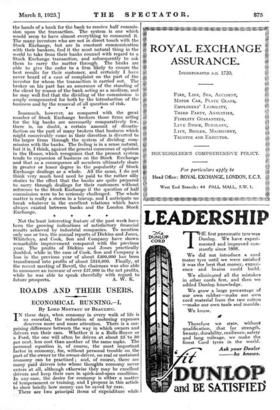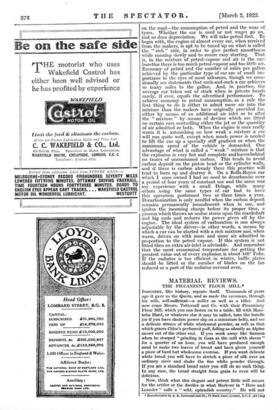ROADS AND THEIR USERS.
ECONOMICAL RUNNING.—I.
By LORD MONTAGU OF BEAULIEU.
IN these days, when economy in every walk of life is so essential, the reduction of motoring expenses deserves more and more attention. There is a sur- prising difference between the way in which owners and drivers run their cars. Whether it is a Rolls-Royce or a Ford, the one will often be driven at about 25 to 80 per cent. less cost than another of the same mike. The personal equation is, of course, the most important factor in economy, for, without personal trouble on the part of the owner br the owner-driver, no real or sustained economy can be practised ; and, of course, there arc many paid drivers into whose thoughts economy never enters at all, although otherwise they may be excellent drivers and keep their cars in spick-and-span condition. In any case, the desire for economy is either a matter of temperament or training, and I propose in this article to show briefly how money can be saved by care.
There are two principal items of expenditure while
on the road—the consumption of petrol and the wear of tyres. Whether the car is used or not wages go on, and so does depreciation. We will take petrol first. To begin with, the engine of almost every car, when received from the makers, is apt to be tuned up on what is called the " rich " side, in order to give perfect smoothness while running slowly and to secure easy. starting. That is, in the mixture of petrol-vapour and air in the car- burettor there is too much petrol-vapour and too little air. Economy of petrol and the number of miles per gallon achieved by the particular type of car are of small im- portance in the eyes of most salesmen, though we occa- sionally see statements that such-and-such a car achieves so many miles to the gallon. And, in practice, the average car taken out of stock when in private hands rarely, if ever, equals the advertised performance. To achieve economy in petrol consumption, as a rule the first thing to do is either to admit more air into the- mixture than the makers have originally provided for, either by means of an additional air inlet or to alter the " mixture " by -means of devices which are fitted on certain cars controlling either the jet or the quantity of air admitted or both. When the engine is once really warm it is astonishing on how weak a mixture a car will run quite well, except when much power is needed to lift the car up a specially stiff gradient or when the maximum speed of the vehicle is demanded. One advantage of what is called a " weak " mixture is that the explosion is very hot and complete and leaves behind no traces of unconsumed carbon. This tends to avoid carbon deposit on the piston head or the cylinder walls, and if there is carbon already there this practice will tend to burn up and destroy it. On a Rolls-Royce car which I once owned I had no need to decarbonize over a period of four years of constant use and the same was my experience with a small Delage, while many others using the same types of car had to have this operation performed two or- three times a year. Decarbonization is only needful when the carbon deposit remains permanently incandescent when in use, and ignites the incoming charge before its proper time, a process which throws an undue strain upon the crankshaft and big ends and reduces the power given off by the engine. The ideal system of carburation is one always adjustable by the driver—in other words, a means by which a car can be started with a rich mixture and, when warm, driven on with more and more air admitted in proportion to the petrol vapour. If this system is not fitted then an extra air-inlet is advisable. And remember that the most economical temperature for getting the greatest value out of every explosion is about 180° Fain.. If the radiator is too efficient in winter, baffle plates should be fitted or the number of blades on the fan reduced or a part of the radiator covered over,











































 Previous page
Previous page